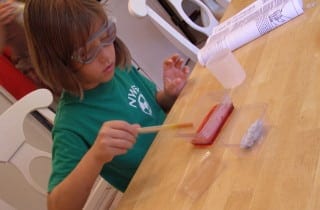Looking for a way to integrate STEM into your daily activities? Step into a fully functioning early childhood science laboratory. Attendees learned how to intrigue and motivate their PreK to second grade students to be super scientists.
Google Hangouts began as a way for friends to meet online to chat about random topics. As time went on, people discovered that the platform is perfect for gathering a group of classmates to study. Shannon Holden showed teachers how to leverage the power of Google Hangouts to provide “anytime – anywhere” learning and student collaboration.
American history takes on new and personal meaning for students when they assume the roles of teens in our country’s most pivotal times, from the American Revolution to the turbulent early 1900’s, as we evolved further as a nation of immigrants.
Waiting until learning is complete to correct gaps or misconceptions can sometimes be too late. Changing instruction in the moment as a response to how and what students are learning is the key to ensuring that all students succeed. Technology certainly makes the formative assessment process easier and more effective.
It’s time for our annual app review! Participants discovered apps that change the way students and teachers think about learning. The presentation featured apps that promote essential 21st century learning skills – creativity, critical thinking, collaboration, and communication.
Research continues to emphasize how important the first five years of a child’s life are for brain development. Music can be an enjoyable and easy way for educators to support the development of important structural changes, neurological processes, and cognitive skills during this very active time of brain development.
What do the most difficult assessment items look like in English Language Arts and Math? How can we prepare our students for increased rigor on Common Core Assessments, including those aligned assessments in Advanced Placement Courses, International Baccalaureate, and on the SAT and ACT exams?
When children use challenging behavior, it is an opportunity to teach them how to become emotionally aware problem-solvers that can use healthy coping strategies in difficult moments. There are four steps that offer a simple, kind, strength-based, commonsense and effective strategy, for day-to-day challenges and challenging behaviors from children (ages 3-8).
Attendees of this webinar learned about the Visual Immersion Program by exploring its core beliefs: the 7 functions of communication, foundational tools, emerging familiarity, and emergent understanding. Participants learned about assistive technology tools, including low-tech versus high-tech, foundational apps/devices, emerging familiarity apps/devices, and emergent understanding apps/devices.










